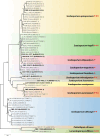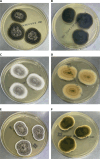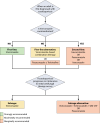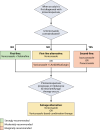Scedosporiosis and lomentosporiosis: modern perspectives on these difficult-to-treat rare mold infections
- PMID: 38551323
- PMCID: PMC11237582
- DOI: 10.1128/cmr.00004-23
Scedosporiosis and lomentosporiosis: modern perspectives on these difficult-to-treat rare mold infections
Abstract
SUMMARYAlthough Scedosporium species and Lomentospora prolificans are uncommon causes of invasive fungal diseases (IFDs), these infections are associated with high mortality and are costly to treat with a limited armamentarium of antifungal drugs. In light of recent advances, including in the area of new antifungals, the present review provides a timely and updated overview of these IFDs, with a focus on the taxonomy, clinical epidemiology, pathogenesis and host immune response, disease manifestations, diagnosis, antifungal susceptibility, and treatment. An expansion of hosts at risk for these difficult-to-treat infections has emerged over the last two decades given the increased use of, and broader population treated with, immunomodulatory and targeted molecular agents as well as wider adoption of antifungal prophylaxis. Clinical presentations differ not only between genera but also across the different Scedosporium species. L. prolificans is intrinsically resistant to most currently available antifungal agents, and the prognosis of immunocompromised patients with lomentosporiosis is poor. Development of, and improved access to, diagnostic modalities for early detection of these rare mold infections is paramount for timely targeted antifungal therapy and surgery if indicated. New antifungal agents (e.g., olorofim, fosmanogepix) with novel mechanisms of action and less cross-resistance to existing classes, availability of formulations for oral administration, and fewer drug-drug interactions are now in late-stage clinical trials, and soon, could extend options to treat scedosporiosis/lomentosporiosis. Much work remains to increase our understanding of these infections, especially in the pediatric setting. Knowledge gaps for future research are highlighted in the review.
Keywords: Lomentospora; Scedosporium; fungi.
Conflict of interest statement
C.F.N. has received a fellowship grant from Gilead Sciences Australia. S.C.-A.C. received untied research funding from MSD Australia and F2G outside of the submitted work. F.L. received speaker fees from Gilead, MSD, Pfizer, and F2G, and serves advisory board for F2G. S.Y.T. is supported by the University of Melbourne for her PhD and received a grant from Gilead Sciences for a project unrelated to the submitted work. S.E.K. received conference and travel funding from Pfizer, AusDiagnostics, received speaker fees from Pfizer, and serves advisory board for Gilead Sciences. D.C.M.K. received grants from F2G unrelated to the submitted work. M.H. received research funding from Gilead Sciences, Astellas, MSD, IMMY, Mundipharma, Pulmocide, Scynexis, F2G, and Pfizer—all outside of the submitted work. M.A.S. has been on data safety, adjudication or advisory committees for Gilead Sciences, F2G, Cidara, Takeda, Merck, Roche, and Pfizer; and received research funding from Gilead Sciences, Merck, and F2G unrelated to the submitted work. All other authors declare no conflicts of interest.
Figures

 the most common causative strain,
the most common causative strain,  occasional occurrence, and
occasional occurrence, and  rare occurrence.
rare occurrence.







Similar articles
-
Clinical significance and antifungal susceptibility profile of 103 clinical isolates of Scedosporium species complex and Lomentospora prolificans obtained from NIH patients.J Clin Microbiol. 2025 Apr 9;63(4):e0155024. doi: 10.1128/jcm.01550-24. Epub 2025 Mar 7. J Clin Microbiol. 2025. PMID: 40052805 Free PMC article.
-
In Vivo Efficacy of Olorofim against Systemic Scedosporiosis and Lomentosporiosis.Antimicrob Agents Chemother. 2021 Sep 17;65(10):e0043421. doi: 10.1128/AAC.00434-21. Epub 2021 Jul 12. Antimicrob Agents Chemother. 2021. PMID: 34252298 Free PMC article.
-
Fusarium species,Scedosporium species, and Lomentospora prolificans: A systematic review to inform the World Health Organization priority list of fungal pathogens.Med Mycol. 2024 Jun 27;62(6):myad128. doi: 10.1093/mmy/myad128. Med Mycol. 2024. PMID: 38935914 Free PMC article.
-
Prognostic factors in 264 adults with invasive Scedosporium spp. and Lomentospora prolificans infection reported in the literature and FungiScope®.Crit Rev Microbiol. 2019 Feb;45(1):1-21. doi: 10.1080/1040841X.2018.1514366. Epub 2019 Jan 10. Crit Rev Microbiol. 2019. PMID: 30628529
-
Deciphering Unexpected Vascular Locations of Scedosporium spp. and Lomentospora prolificans Fungal Infections, France.Emerg Infect Dis. 2024 Jun;30(6):1077-1087. doi: 10.3201/eid3006.231409. Emerg Infect Dis. 2024. PMID: 38781681 Free PMC article. Review.
Cited by
-
Successful Treatment of Lomentospora Prolificans Infection Following Allogeneic Hematopoietic Stem Cell Transplantation: A Case Report and Literature Review.Infect Drug Resist. 2025 Jul 23;18:3617-3628. doi: 10.2147/IDR.S529984. eCollection 2025. Infect Drug Resist. 2025. PMID: 40718369 Free PMC article.
-
Clinical significance and antifungal susceptibility profile of 103 clinical isolates of Scedosporium species complex and Lomentospora prolificans obtained from NIH patients.J Clin Microbiol. 2025 Apr 9;63(4):e0155024. doi: 10.1128/jcm.01550-24. Epub 2025 Mar 7. J Clin Microbiol. 2025. PMID: 40052805 Free PMC article.
-
Necrotizing orbital infections: A comprehensive review.Saudi J Ophthalmol. 2025 Jun 25;39(2):128-140. doi: 10.4103/sjopt.sjopt_87_25. eCollection 2025 Apr-Jun. Saudi J Ophthalmol. 2025. PMID: 40642363 Free PMC article.
-
The top 10 papers on the treatment of invasive fungal infections, 2018-2023.Ther Adv Infect Dis. 2024 Oct 21;11:20499361241290349. doi: 10.1177/20499361241290349. eCollection 2024 Jan-Dec. Ther Adv Infect Dis. 2024. PMID: 39440156 Free PMC article.
-
Extracellular Vesicles from Scedosporium apiospermum Mycelial Cells: Implication for Fungal-Host Interplays.J Fungi (Basel). 2024 Apr 9;10(4):277. doi: 10.3390/jof10040277. J Fungi (Basel). 2024. PMID: 38667948 Free PMC article.
References
-
- Neoh CF, Chen SCA, Crowe A, Hamilton K, Nguyen Q, Marriott D, Trubiano JA, Spelman T, Kong DCM, Slavin MA. 2023. Invasive Scedosporium and Lomentospora prolificans infections in Australia: a multicentre retrospective cohort study. Open Forum Infect Dis:10:ofad059. doi:10.1093/ofid/ofad059 - DOI - PMC - PubMed
-
- Jenks JD, Seidel D, Cornely OA, Chen S, van Hal S, Kauffman C, Miceli MH, Heinemann M, Christner M, Jover Sáenz A, et al. . 2020. Voriconazole plus terbinafine combination antifungal therapy for invasive Lomentospora prolificans infections: analysis of 41 patients from the FungiScope registry 2008-2019. Clin Microbiol Infect 26:784. doi:10.1016/j.cmi.2020.01.012 - DOI - PubMed
-
- Jenks JD, Seidel D, Cornely OA, Chen S, van Hal S, Kauffman C, Miceli MH, Heinemann M, Christner M, Jover Sáenz A, Burchardt A, Kemmerling B, Herbrecht R, Steinmann J, Shoham S, Gräber S, Pagano L, Deeren D, Slavin MA, Hoenigl M. 2020. Clinical characteristics and outcomes of invasive Lomentospora prolificans infections: analysis of patients in the FungiScope registry. Mycoses 63:437–442. doi:10.1111/myc.13067 - DOI - PubMed
-
- Seidel D, Hassler A, Salmanton-García J, Koehler P, Mellinghoff SC, Carlesse F, Cheng MP, Falces-Romero I, Herbrecht R, Jover Sáenz A, Klimko N, Mareş M, Lass-Flörl C, Soler-Palacín P, Wisplinghoff H, Cornely OA, Pana Z, Lehrnbecher T. 2020. Invasive Scedosporium spp. and Lomentospora prolificans infections in pediatric patients: analysis of 55 cases from FungiScope and the literature. Int J Infect Dis 92:114–122. doi:10.1016/j.ijid.2019.12.017 - DOI - PubMed
-
- Seidel D, Meißner A, Lackner M, Piepenbrock E, Salmanton-García J, Stecher M, Mellinghoff S, Hamprecht A, Durán Graeff L, Köhler P, et al. . 2019. Prognostic factors in 264 adults with invasive Scedosporium spp. and Lomentospora prolificans infection reported in the literature and FungiScope. Crit Rev Microbiol 45:1–21. doi:10.1080/1040841X.2018.1514366 - DOI - PubMed
Publication types
MeSH terms
Substances
Supplementary concepts
LinkOut - more resources
Full Text Sources

